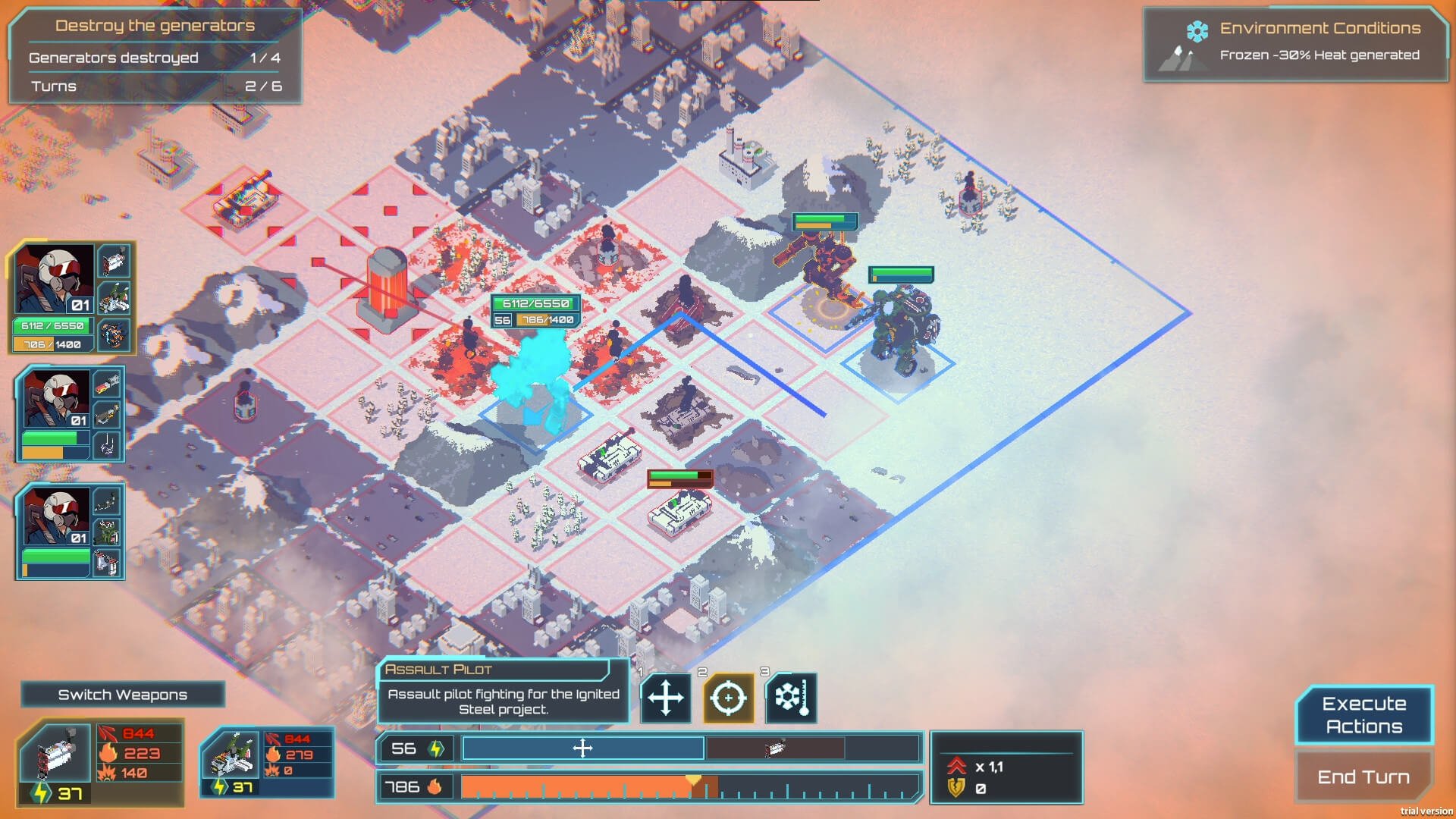Ignited Steel: Mech Tactics is a turn-based combat game with mechas, drawing heavy inspiration from Subset Games titles FTL: Faster Than Light and Into the Breach. So, how does it compare against its older counterparts in the genre? Discover the answer in this review!
Story
The story is simple: The AI, named PharOS, has gone rogue. It has taken control of all the automatic mechs in the worlds, and is using them to control the population. The only machines, which are unaffected, are those requiring a pilot. So, now our heroes, the pilots, must employ those, to battle the PharOS mech army and liberate the world.
The story doesn’t get in the way much: there’s just a little cutscene at the start and one at the end, setting the tone. There are also some narrative events you’ll encounter, and they can add some flavor to the game. Their main purpose, however, seemed to be to just trigger special fights (just like in FTL). It’s not really a problem in terms of the gameplay, but it can be somewhat disappointing for lore fans. I’d like to see a bit more information about the bosses too. They do look very cool but, at the moment, lack any background story.

Gameplay
The game divides into two parts. There is this FTL style screen where you choose your next battle. And then there are the battles, where most of the fun happens. The former, called the Star Map, isn’t very interesting: You select a mission, maybe change your loadout, and that’s it. You can only choose between two missions at most, and there isn’t much info on the future battles – so no reason to plan ahead. There’s no lore, and nothing happens to those planets that aren’t liberated. It’s just a mission list.
The other part are the battles. After the map and the objective are shown, you position your mechs and go to town. Although the positioning is really restrictive, the combat itself is solid. It uses an AP-based system, that works quite well here. Each of the player’s mechs has AP and heat. Walking and shooting your guns consumes the former, and generates a set amount of the latter. By the way, while there are some options to decrease heat – these also seem relatively limited.

Each unit has a heat meter. The more heated a unit is, the more damage it deals and receives. Each enemy unit also has a different special effect when overheated: receiving a burst of damage, or rooting itself. There are weapons and support equipment, that can manipulate yours and the enemy’s heat bars. All in all, a quite fun mechanic. My only problem is with the environment effects, that change their intensity too much, making it hard to gauge how much heat a mech generates.
If you like mecha battles, it’s quite possible you’ll enjoy this game. The combat is good, most of the time, and the UI is great. There is a ton of equipment – and each has its use. True, there are moments when the game feels unbalanced. However – the devs patched it fast during the beta, so I’m inclined to think that the game will be getting regular balance patches.
Difficulty and Game Length
This game has a somewhat unexpected run length. I was thinking it’d be something like Into the Breach thirty minutes. In the end, it’s more like a two-hour session of BattleTech. In the same time, it really doesn’t feel like there is any benefit to this, as the battles do become repetitive after a while.
I also felt that while it starts hard, it becomes easy just after the first boss. Your mechs scale, while the enemies’ don’t. Losing a pilot is a nuisance, but you do keep the mech and all the equipment. In the end, it becomes thirty minutes of fairly hard gameplay followed by one hour of easy battles, that slowly become repetitive. The economy too is much the same: going from absolutely unforgiving to “buy everything you can”.

Another problem I had was with the environment effects. Heat plays a big part in this game: the Arid and Cold effects raise or reduce heat accumulation by an astounding 50%! For such an important mechanic, it’s strange to have its effects swing by so much. The Arid, especially, is too intense – some of my robots were overheating with just one attack. Almost all maps have these modifiers – would definitely be nice to see some that don’t.
Visuals and Soundtrack
The game looks quite good with its voxel graphics and beautifully drawn maps. Not incredible, but competent and generally easy to read. It’s possible to see what weapons a robot is using, and these become orange when warming up – which is a nice touch. Although I still did find a few small issues with the UI.
When some units have a delayed attack, they mark their targets with a red square, which can easily crowd the map, making it hard to see your attack range. This game also isn’t very friendly to colorblind people at the moment, judging from the feedback on color hues. The animations too feel a little off sometimes, for example during shooting. It is just too fast, and it loses the punch because of it.

The soundtrack works rather well, avoiding that 8-buit style that would be so easy to use. The only problem is that it can get a little repetitive, considering how long the runs are. The sound effects, too, are quite good and definitely fit the weapons and the events.
Replay Value
This game has a fair bit of replay value. It has many pilots, with different abilities, and mech loadouts to explore. On the other hand, the maps don’t vary too much and the objectives are few and not very interesting.

Overall, it’s a good game to go through. Maybe even playing it on and off, which’ll keep it fresh for a bit longer. Still, I can’t imagine that there are many players who’d want to play it over and over again. It is that kind of game that you play for a while, then lay it down – to revisit at some later day in the future, and play a little more again.







